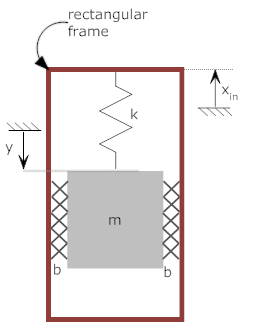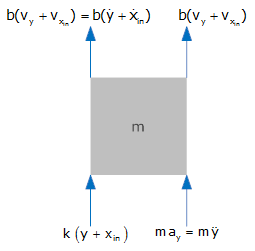Example: Rework of "Example: System Defined by Relative Displacements" without relative displacements
Differences between this example and the original are given as bold italics.
In the system below a mass, m, is hung from a rectangular frame by a spring (k). There is viscous friction between the frame and the mass on either side (b). The distance xin positive upwards) is measured from a fixed reference and defines the position of the frame. The distance y (measured downwards) is the position of the mass relative to a fixed reference.

Reworked system
Let's draw a free body diagram of the reworked system. Again, we only need one free body diagram becasue the position xin is known; only y is unknown. There are then four forces in the free body diagram:
- The force from the spring. This is equal to k·(y+xin), upwards. (If either xin or y increases the spring elongates resulting in an upward force)
- The force from the friction on the left side of the mass. This is equal to k·(vy+vxin), upwards (vy is the first derivative of y with respect to time, i.e., the velocity; vxin is the derivative of xin)).
- The force from the friction on the right side; this is also equal to k·(vy+vxin).
- D'Alembert's force is upward and equal to m·ay, where ay is the second derivative of y with respect to time.
These are shown below, along with the resulting equations of motion.
 |
 |
For comparison the original system is shown below.

Original System
Examing the two depictions of the system we can clearly see that z=xin+y (if xin increases and y remains constant, z increases; if y increases while xin remains constant, z also increases), or y=z-xin. Replacing y by z-xin by the result above yields the original result.
